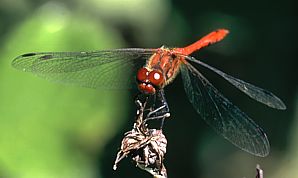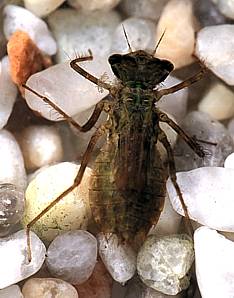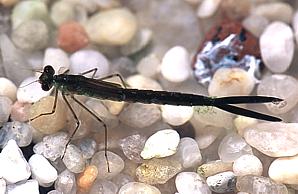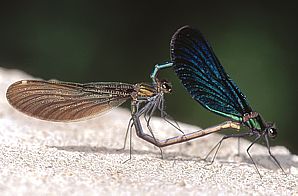|
AQUATIC INSECTS
|
||||||||||||
Text:
|
Odonates: dragonflies and damselflies
ODONATES Odonata are not a very numerous group of insects connected with water environment. There are 72 species of dragonflies which constitutes for 56, 2% of all species listed all over Europe. Adult odonates are insects of average or large body size. They have large eyes, short feelers and often intensive and rich colouration. As far as larvae are concerned, the pungent-type mouth takes a form of the so-called mask with a fully developed bottom lip functioning as a prehensile organ. Larvae lead a water mode of life while adult insects are terrestrial. Odonates are met in all types of fresh-water reservoirs and the factors determining the kind of dragonflies is the character of vegetation in the given reservoir. Most species settle lakes and ponds; considerably few live in rivers and streams. Larvae of odonates are mostly connected with a littoral zone and they live in depths reaching several meters. Some larvae creep over the water plants; others dig themselves in the mud or in sand.
European Odonate species are divided into two subgroups: the homopterous dragonflies Zygoptera and the heteropterous damselflies Anisoptera. The homopterous dragonflies have a characteristic long thin abdomen, a large distance between the complex eyes (even greater than the width of eye) and two pairs of almost identical wings which, when in the resting position, are placed on the back with the surface upwards or slightly sloping backwards. The heteropterous damselflies have a fat abdomen, a smaller distance between the complex eyes and their frontal wings are different from the back ones (in the resting position the back wings stay outspread). As far as larvae of both subgroups are concerned, their external appearance is different, too: the larvae of Anisoptera have a heavy massive body construction while Zygopteras' body construction is slender and delicate.
All odonates - both larvae as well as adult individuals - are predacious. Depending on the body size the larvae of odonates eat water microorganisms, crustaceans, distomas and other parasite animals, eelworms, water insects, fishes and larvae of amphibians.
Adult odonates are active in the daytime. They are perfect aviators and they can fly at the speed of 15 meters per second. They are able to perform impetuous turns, fly backwards or even hang in the air just like a helicopter. The skill of precise flight helps them hunt for insects efficiently (butterflies, cockchafers, wasps, Diptera and other dragonflies). If the trophy is not too large dragonflies can devour it during their flight.
Male dragonflies keep other males off their own districts where they are on the lookout for the females. The act of copulation of odonates takes place during the flight and it is a complicated activity. At first the male, which espied the female of its own sort, grabs her body with the limbs. Then, depending on the sort of dragonflies, it grabs female's occiput or a pretrunk with its tongs-like abdomen's limbs and during the short flight the male transfers the sperm from the end of its abdomen to the second abdomen's ring where there is a proper copulatory organ. Only then the act of copulation takes place during which the female bends her abdomen and attaches it to male's copulatory device. Such a joint pair can fly up to tens of minutes. After the copulation the male leaves the female or accompanies her, partly joint, while laying the eggs. Eggs can be placed directly into water, on the tissues of water plants or in mud. Larvae are hatched after 2-5 weeks. During the growth the larva moults many times (from 10 to 15 times ), grows up to the final size and leaves the water environment to be transformed. The phase of chrysalis does not take place. An adult larva climbs up the nearby plants or the objects protruding from water, breathing with pretracheas placed on the pretrunk. The skin on larva's back cracks and an adult insect goes through this crevice. At first the body of such a dragonfly is soft and lacks the color. The body becomes stiff after 1-2 hours from leaving the moulting skin and the proper colors appear in several days' time.
There are 40 species of odonates in the area of Wigry National Park but the present research will certainly show the presence of further species and species. Four species are subject to the legal protection: Ophiogomphus cecilia, Aeshna viridis, Leucorrhinia albifrons and Leucorrhinia pectoralis. There are also two very rare species of odonates living in the Park area only. These two species live in the vicinity of dystrophic mid-forest lakes and they include: the Euroasian Epitheca bimaculata and the Euro Siberian Libellula fulva.
The species of odonates to be met in the area of Wigry National Park :
The dragonflies Anisoptera
The damselflies Zygoptera
|
|||||||||||
|
|
|




